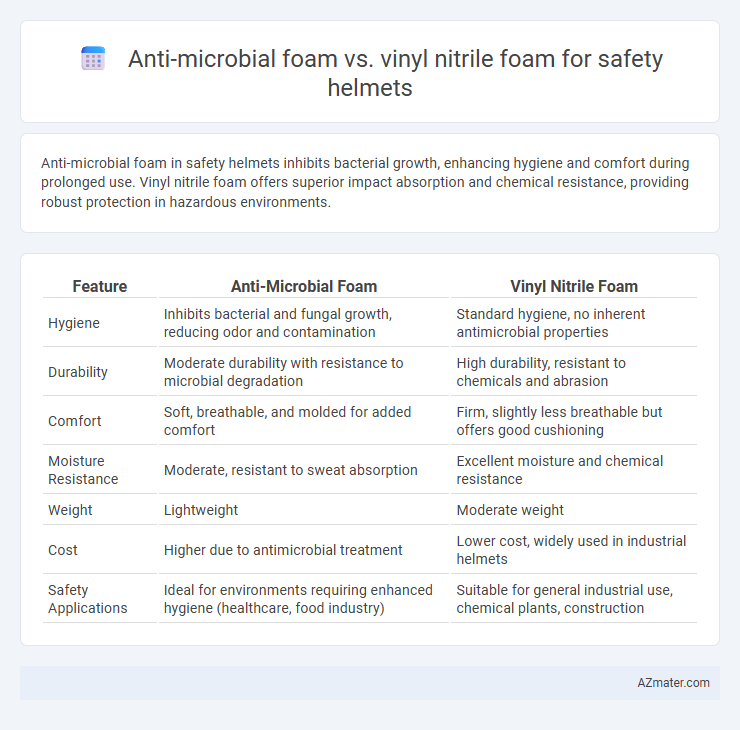Anti-microbial foam in safety helmets inhibits bacterial growth, enhancing hygiene and comfort during prolonged use. Vinyl nitrile foam offers superior impact absorption and chemical resistance, providing robust protection in hazardous environments.
Table of Comparison
| Feature | Anti-Microbial Foam | Vinyl Nitrile Foam |
|---|---|---|
| Hygiene | Inhibits bacterial and fungal growth, reducing odor and contamination | Standard hygiene, no inherent antimicrobial properties |
| Durability | Moderate durability with resistance to microbial degradation | High durability, resistant to chemicals and abrasion |
| Comfort | Soft, breathable, and molded for added comfort | Firm, slightly less breathable but offers good cushioning |
| Moisture Resistance | Moderate, resistant to sweat absorption | Excellent moisture and chemical resistance |
| Weight | Lightweight | Moderate weight |
| Cost | Higher due to antimicrobial treatment | Lower cost, widely used in industrial helmets |
| Safety Applications | Ideal for environments requiring enhanced hygiene (healthcare, food industry) | Suitable for general industrial use, chemical plants, construction |
Introduction to Safety Helmet Foams
Safety helmet foams are crucial for impact absorption and comfort, with materials such as anti-microbial foam and vinyl nitrile foam commonly used in protective headgear. Anti-microbial foam inhibits bacterial growth, enhancing hygiene and reducing odor during prolonged use, while vinyl nitrile foam offers superior cushioning and resistance to oils and chemicals, ensuring durability in harsh environments. Selecting the appropriate foam depends on application requirements, balancing hygiene benefits with mechanical performance for optimal helmet safety and user comfort.
Overview of Anti-Microbial Foam Technology
Anti-microbial foam in safety helmets utilizes advanced biocidal agents embedded within the foam matrix to inhibit the growth of bacteria, fungi, and other microorganisms, enhancing hygiene and reducing odor over prolonged use. This technology maintains foam integrity and breathability while offering superior protection against microbial contamination compared to traditional vinyl nitrile foam, which primarily provides cushioning and impact resistance without inherent anti-microbial properties. Integration of anti-microbial agents in helmet foam aligns with workplace health standards, improves user comfort, and extends the lifespan of protective headgear in environments prone to sweat and dirt accumulation.
Key Features of Vinyl Nitrile Foam
Vinyl nitrile foam offers superior chemical resistance, excellent cushioning, and long-term durability compared to anti-microbial foam, making it ideal for safety helmet liners exposed to harsh environments. Its closed-cell structure provides enhanced moisture resistance, preventing bacterial growth while maintaining structural integrity under compression. The foam's lightweight and flexible properties contribute to improved wearer comfort without compromising impact absorption performance.
Impact Absorption Comparison
Anti-microbial foam offers enhanced protection by combining impact absorption with resistance to microbial growth, maintaining hygiene without compromising safety. Vinyl nitrile foam excels in impact absorption through its closed-cell structure, providing superior shock attenuation and durability under repeated impacts. Comparing the two, vinyl nitrile foam delivers higher energy dissipation for impact protection, while anti-microbial foam adds value in environments requiring sanitation alongside impact resistance.
Hygiene and Microbial Resistance
Anti-microbial foam in safety helmets offers superior hygiene by actively inhibiting bacterial and fungal growth, significantly reducing odor and skin irritation risks during extended wear. Vinyl nitrile foam, while durable and resistant to oils and chemicals, lacks inherent antimicrobial properties, making it less effective at preventing microbial contamination. Choosing anti-microbial foam enhances microbial resistance and maintains a cleaner helmet environment, crucial for user health and comfort.
Durability and Longevity
Anti-microbial foam in safety helmets offers superior protection against bacterial growth, enhancing hygiene and reducing odor over extended use. Vinyl nitrile foam excels in durability, providing excellent resistance to compression set and maintaining cushioning properties under repeated impact. Combining both materials optimizes helmet longevity by balancing antimicrobial protection with long-lasting structural integrity.
Comfort and Fit: User Perspectives
Anti-microbial foam in safety helmets offers enhanced hygiene by reducing odor-causing bacteria, improving comfort during extended wear compared to vinyl nitrile foam. Vinyl nitrile foam provides superior cushioning and shock absorption, contributing to a snug fit that adapts well to various head shapes. Users often prefer anti-microbial foam for its breathability and long-term freshness, while vinyl nitrile foam is favored for its durable support and impact protection.
Weight and Breathability Considerations
Anti-microbial foam used in safety helmets offers superior breathability compared to vinyl nitrile foam, allowing better moisture and heat dissipation, which enhances wearer comfort during prolonged use. Vinyl nitrile foam, while generally heavier, provides excellent impact resistance and durability but may compromise ventilation, potentially leading to increased heat retention. Prioritizing weight, anti-microbial foam typically results in a lighter helmet, reducing fatigue, whereas vinyl nitrile foam helmets tend to be bulkier due to denser material composition.
Cost Analysis and Availability
Anti-microbial foam for safety helmets typically incurs higher costs due to specialized treatments that inhibit bacterial growth, while vinyl nitrile foam offers a more cost-effective alternative with widespread availability and established supply chains. Vinyl nitrile foam provides consistent cushioning and durability at a lower price point, making it a preferred choice for large-scale manufacturing and budget-sensitive projects. Availability of vinyl nitrile foam is generally more reliable globally, whereas anti-microbial foam may face supply constraints depending on the technology provider and regional demand.
Final Verdict: Which Foam is Better for Safety Helmets?
Anti-microbial foam offers superior hygiene by inhibiting bacterial growth, making it ideal for helmets used in environments prone to sweat and moisture. Vinyl nitrile foam excels in impact absorption and durability, providing enhanced protection and long-lasting comfort during extended use. The better choice for safety helmets depends on prioritizing hygiene for user health or impact protection for safety performance.

Infographic: Anti-microbial foam vs Vinyl nitrile foam for Safety helmet
 azmater.com
azmater.com